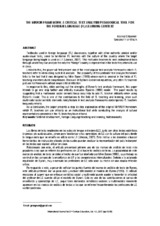Mostrar el registro sencillo del ítem
The mirror framework: a critical text analysis pedagogical tool for the foreign language (FL) learning context
| dc.contributor.author | Cremona, George | |
| dc.date.accessioned | 2018-11-26T08:52:13Z | |
| dc.date.available | 2018-11-26T08:52:13Z | |
| dc.date.issued | 2017 | |
| dc.identifier.issn | 2444-3921 | |
| dc.identifier.uri | http://hdl.handle.net/10396/17535 | |
| dc.description.abstract | Textbooks used in foreign language (FL) classrooms, together with other authentic printed and/or audio-visual texts, serve to familiarise FL learners with the culture of the country where the target language being taught is used as L1 (Unesco, 2007). This motivates teachers to seek instructional tools through which they can analyze the way the „foreign‟ country is represented in the texts they intend to use in class. Linked to this, the paper will first present one of the most popular text analysis frameworks which FL teachers refer to when doing such text analysis. The popularity of this particular text analysis framework links to the fact that it was designed by Mike Byram (1993) whose work is seminal in the fields of FL teaching and intercultural competences. Because of Byram‟s acclaimed reputation, very often FL teachers just use his framework without ample critical reflection. In response to this, while pointing out the strengths of Byram's text analysis framework, this paper intends to go one step further and critically evaluates Byram's (1993) model. The paper reacts by suggesting that a multimodal social semiotic focus may help to add FL teacher criticality when using Byram‟s model. This is one of the contributions to the field of FL teaching and learning, since such multimodal social semiotic elements rarely feature in text analysis frameworks contemporary FL teachers frequently refer to. As a conclusion, the paper presents a step by step explanation of the original MIRROR framework which FL teachers can use critically as an instructional tool while conducting the analysis of cultural representations presented in the FL texts they have at hand. | es_ES |
| dc.description.abstract | Los libros de texto empleados en las aulas de lengua extranjera (LE), junto con otros textos auténticos impresos y/o audiovisuales, sirven para familiarizar a los aprendices de LE con la cultura del país donde la lengua meta que se enseña se utilize como L1 (Unesco, 2007). Esto motiva a los docentes a buscar herramientas de instrucción a través de las cuales puedan analizar la representación del país „extranjero‟ en los textos que aspiran utilizar en clase. Relacionado con esto, el artículo presentará primero uno de los marcos de análisis de texto más populares a los que se refieren los profesores de LE al hacer tal análisis de texto. La popularidad de este marco de análisis de texto se debe al hecho de que fue diseñado por Mike Byram (1993), cuyo trabajo es seminal en los campos de la enseñanza de LE y las competencias interculturales. Debido a la aclamada reputación de Byram, muy a menudo los profesores de LE solo usan su marco sin una amplia reflexión crítica. En respuesta a esto, a pesar de señalar los puntos fuertes del marco de análisis de texto de Byram, este artículo pretende dar un paso más y evaluar críticamente el modelo de Byram (1993). El artículo reacciona al sugerir que un enfoque semiótico social y multimodal puede ayudar a fomentar la criticidad del profesor de LE cuando utiliza el modelo de Byram. Esta es una de las contribuciones al campo de enseñanza y aprendizaje de LE, yaque tales elementos semióticos sociales y multimodales raramente aparecen en los marcos de análisis de textos a los que se refieren frecuentemente los profesores de LE contemporáneos. A modo de conclusión, el artículo presenta una explicación paso a paso del marco original MIRROR que los profesores de LE pueden utilizar de manera crítica y como herramienta de instrucción a la hora de realizar el análisis de las representaciones culturales presentadas en los textos de LE estudiados. | es_ES |
| dc.format.mimetype | application/pdf | es_ES |
| dc.language.iso | eng | es_ES |
| dc.publisher | Universidad de Córdoba, UCOPress | es_ES |
| dc.rights | https://creativecommons.org/licenses/by-nc-nd/4.0/ | es_ES |
| dc.source | International Journal for 21st Century Education 4(1), 43-56 (2017) | es_ES |
| dc.subject | Material development | es_ES |
| dc.subject | Foreign Language teaching and learning | es_ES |
| dc.subject | Multidmodality | es_ES |
| dc.subject | Desarrollo de material | es_ES |
| dc.subject | Enseñanza y aprendizaje de lenguas extranjeras | es_ES |
| dc.subject | Multidmodalidad | es_ES |
| dc.title | The mirror framework: a critical text analysis pedagogical tool for the foreign language (FL) learning context | es_ES |
| dc.type | info:eu-repo/semantics/article | es_ES |
| dc.relation.publisherversion | http://www.uco.es/ucopress/ojs/index.php/ij21ce/index | es_ES |
| dc.rights.accessRights | info:eu-repo/semantics/openAccess | es_ES |

